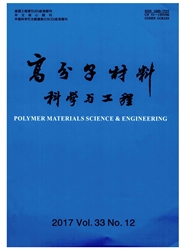

 中文摘要:
中文摘要:
研究了弹性体(POE)、滑石粉、偶联剂和填料处理方式对聚丙烯(PP)的力学性能、加工性能、结晶行为以及无机粒子在基体中分散形态的影响。结果表明,PP2(K7726)/POE(80/20)二元共混体系的综合性能较好;采用方式C(将两种偶联剂按1:1的质量比,先加钛酸酯后加硅烷处理滑石粉)制得的PP2/POE/Talc(80/20/25)三元复合材料的力学性能比其它两种方式有显著提高。偏光显微镜(PLM)研究表明,方式C处理的滑石粉在体系中分散性最好;扫描电镜(SEM)显示,三元复合体系由PP2/POE耗能少的空洞化断裂方式向耗能多的剪切屈服方式转变;DSC表明,采用方式C处理的滑石粉对聚丙烯的成核作用减弱。
 英文摘要:
英文摘要:
The effects of POE, talc, coupling agents and treated methods of filler on mechanical properties, melt viscosity, crystallization behavior and dispersing morphology of inorganic particles of PP were studied. It is obtained that comprehensive properties of PP2(K7726)/POE (80/20) binary blends are better than those of PP. Mechanical properties of PP2/POE/Talc ternary composites are greatly increased by methods C, in which talc is treated by organic titanate and silane coupling agent orderly. The results of polarizing microscope indicate that the talc treated by method C has the best dispersion in the matrix. The SEM results reveal that the fracture mode is changed from void formation of PP2/POE to shear-yield formation of PP2/POE/Talc. The DSC results indicate that the talc treated with method C has a low heterogeneous nucleation for PP.
 同期刊论文项目
同期刊论文项目
 同项目期刊论文
同项目期刊论文
 期刊信息
期刊信息
